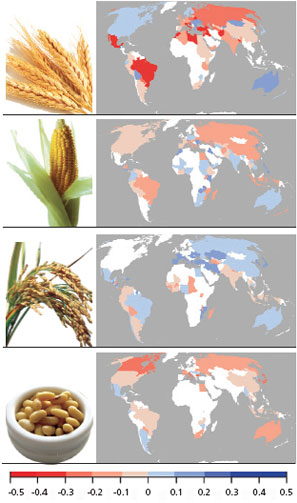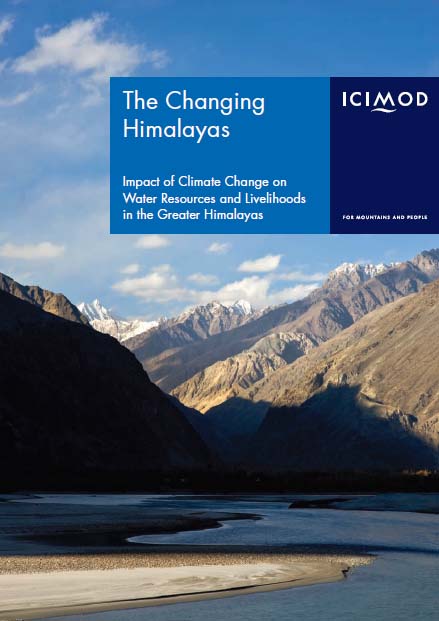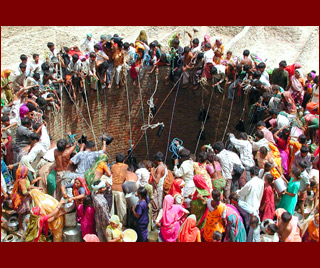Climate and Weather
Climate change hits food production
Posted on 28 Jul, 2011 03:10 PMArticle and Image courtesy: Down To Earth
Author: Indu Mathi S
Global warming has resulted in 20 per cent increase in price of wheat, maize, rice and soybean.
 Estimated impact of climate change on crop production during 1980-2008. Negative values indicate climate change reduced yields
Estimated impact of climate change on crop production during 1980-2008. Negative values indicate climate change reduced yields
There have been many indicators that global warming could be hurting the world food production, lowering yields and increasing prices. Turns out the warming of the planet over the past three decades has already led to a measurable reduction in crop production of wheat and maize.
The changing Himalayas - Impact of climate change on water resources and livelihoods in the Greater Himalayas – A report by ICIMOD
Posted on 27 Jul, 2011 09:56 PM The greater Himalayan region “the roof of the world” – contains the most extensive and rugged high altitude areas on Earth, and the largest areas covered by glaciers and permafrost outside the polar regions.
The greater Himalayan region “the roof of the world” – contains the most extensive and rugged high altitude areas on Earth, and the largest areas covered by glaciers and permafrost outside the polar regions.
The sector programme and climate change initiatives in Uttarakhand
Posted on 27 Jul, 2011 02:54 PMRecent scientific studies show that global warming is already causing environmental changes that will have significant global economic and social impacts. As the world's 4th largest emitter of greenhouse gases, India has to juggle the imperative demand for economic development with pressures for greater efficiency in the use of energy.
Climate change is a change in the statistical properties of the climate system when considered over long periods of time, regardless of cause. Climate change reflects a change in the energy balance of the climate system, i.e. changes the relative balance between incoming solar radiation and outgoing infrared radiation from Earth. The threat emanates from accumulated green house gas emissions in the atmosphere, generated through long term and intensive industrial growth and high consumption life styles of developed countries.
Short course on climate risk screening, AFPRO, September 20 – 21, 2011, New Delhi
Posted on 27 Jul, 2011 11:22 AM Organizer: Action for Food Production
Organizer: Action for Food Production
Venue: AFPRO Training Centre, 25/1A, Institutional Area, Pankha Road, Janakpuri, D-Block, New Delhi
Description:
The course attempts to understand climate change risks and vulnerabilities; introduce concepts and approaches to climate change adaptation; and, thereby provide the participants with a framework for Climate Risk Screening. This in essence will enhance the capacities of the participants to integrate climate change risks and adaptation considerations into their project design and management leading to adaptive planning.
India must prepare for future growth by planning a low-water economy - Article in YaleGlobal Online by Rohini Nilekani
Posted on 19 Jul, 2011 12:37 PMArticle and Image courtesy: YaleGlobal Online
Author: Rohini Nilekani
India and China account for one third of the world’s population; each consumes more freshwater than other nations. Per inhabitant per year, though, India uses less than half what’s used in the US, China uses less than one third. This YaleGlobal series examines India and China’s water use, their expectations for rising demand and recognition that shortages will disrupt economic progress.
The Planning Commission of India repeatedly warns that water will become a more serious issue than land or energy for India in years to come, points out Rohini Nilekani, in the second article of the series. India’s transition from an economy based on agriculture to a mixed one, with water use controlled by states rather than the federal constitution, already leads to conflicts. She urges planning for a low-water economy. Good governance and regulatory frameworks can prevent pollution and waste, while encouraging efficiency, reliable and fair allocation, and wise consumer choices.
 Thirsty earth: Indian villagers in Gujarat gather to draw water from a well
Thirsty earth: Indian villagers in Gujarat gather to draw water from a well
Threat of land subsidence in and around Kolkata City and East Kolkata Wetlands – A paper in Journal of Earth System Science
Posted on 18 Jul, 2011 07:33 PMThis paper in Journal of Earth System Science attempts to estimate the possible rate of land subsidence of Kolkata City including Salt Lake City and the adjoining East Kolkata Wetlands located at the lower part of the deltaic alluvial plain of South Bengal basin. Land subsidence is an environmental hazard which is caused by overdraft of groundwater or oil extraction and results in gradual settling or sudden sinking of the earth’s surface owing to subsurface movement of the materials of the earth.
Impact of climate change on extreme rainfall events and flood risk in India – A paper in Journal of Earth System Science
Posted on 18 Jul, 2011 06:27 AMThe occurrence of exceptionally heavy rainfall events and associated flash floods in many areas during recent years prompted the researchers to study long-term changes in extreme rainfall over India.
Geomorphic study for regeneration of aquatic ecosystem in Bareilly – An article in Geospatial World
Posted on 17 Jul, 2011 10:53 AMIt indicates that the aquatic ecosystem of an area disappeared due to unplanned development of agro ecosystems and human settlements. This area was earlier covered with ponds, wetlands and ox-bow lakes. Now, during the rainy season, inhabitants of these wards face severe problem of water logging and pollution.
Bharti Integrated Rural Development Society invites applications for various positions, Hyderabad – Apply by July 22, 2011
Posted on 15 Jul, 2011 04:31 PMContent courtesy: DevNetJobsIndia
Bharti Integrated Rural Development Society (BIRDS) is a non-profit organization established in 1991 at Nandyal, in Kurnool district of Andhara Pradesh, India. Founded and directed by Paul Raja Rao, BIRDS has grown in the past six years from a grassroots attempt to empower the Dalits and provide a few microfinance loans to groups of women.
APN's call for proposals under ARCP programme and CAPaBLE programme - Apply by July 29, 2011
Posted on 15 Jul, 2011 03:15 PMCountries within the Asia‐Pacific region support more than half of the world’s population and changes in the Earth’s bio geophysical system are clearly impacting the societies and economies of these countries.
The APN is inviting proposals under two separate programmes, the ARCP Programme and the CAPaBLE Programme, for funding from April 2012, and is able to provide a limited amount of financial support1 for research and capacity development activities that fall within its areas of interest.





